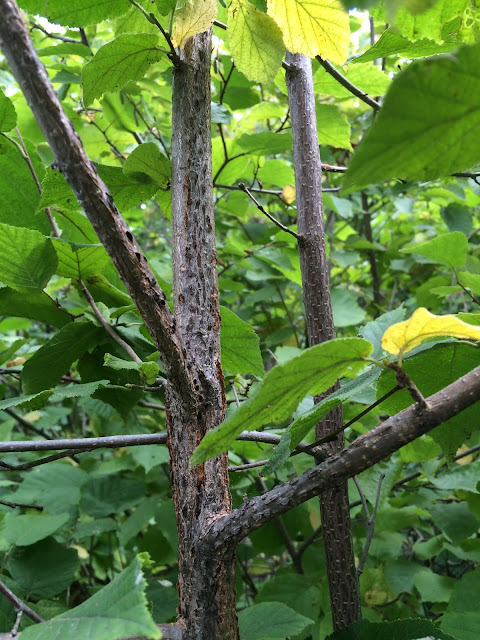Kelsey Dunnell, who has been an important part of the hazelnut research team, has moved to Oregon to finish her PhD at Oregon State University. Good luck Kelsey, & you will be missed!!
The picture on the left is Kelsey at NDSU research arboretum near Absaraka, with her hazelnuts research for NDSU. The picture on the right is Kelsey at Riverbend Hazelnuts research area.
These next pictures are some of the common diseases and insect pests we've had to deal with in this area.
This first picture is not a pest, but Kelsey D. showing the effects of EFB (eastern filbert blight).
This is a close-up of the branch that Kelsey was holding. You can see the row of black cankers of fungus, and the dried area of the branch. This disease is called Eastern Filbert Blight (EFB).
This affected part of the hazelnut has almost decimated the whole plant with EFB.
This is another picture of a branch with EFB.
Can you spot the EFB on this horizontal branch?
This blight was first found by Kelsey during the annual inspection, and positively identified by Jim Walla - Tree Doctor of Northern Tree Specialties. Jim also suggested removing and burning the infected branches before spring to help keep EFB under control. His help is greatly appreciated.
My hope at Riverbend Hazelnuts is to breed a hardy EFB resistant plant with a tasty, large, and thin-shelled nut that grows in this area. Right now we have several plants that almost meet all of these requirements, but there is always room for improvement.
 |
| These are some of the new resistant varieties that have just started producing nuts. |
This is another exceptional plant that has just started producing high quality nuts, and it shows no signs of EFB.
Note the size of the plant against the 7ft fence behind it.
In the past couple of years this pest has started raising his little head. This insect is called the hazelnut weevil. Originally I thought they where the same as the oak/acorn weevil, but found that they are a specific species that just affects the hazelnuts. I have no idea where they came from because the nearest wild hazelnuts are over 30 miles away, so they must have a good nose to smell the nuts from that distance.
These are some of the nuts affected by the weevil larva.
The weevil larva tends to leave the nut a few hours after it has fallen
to the ground, so I try to control the weevil without a pesticide by picking the hazelnuts as early as possible before the larva bores out of the shell, and then dry the nut and husk down inside on a drying racks with trays underneath to catch the weevil larva. This year I did find some larva that had already bored out of the nut while still on the plant, so I might have to change my tactics and use a pesticide. Right now I feel that by keeping all the hazelnuts picked and cleaned off the ground I can control this pest. I estimate that this year I have a lost 1 to 2% of the crop.









Although not harmful to hazelnuts, I do consider Kelsey a pest.
ReplyDeleteWith love,
Brother
Good post and pictures. I never knew what EFB looked like exactly but now I do.
ReplyDeleteI am very happy to discover your post as it will on top in my collection of favorite blogs to visit.
ReplyDeletepest control san antonio
Thank you for your interest in my blog.
Delete